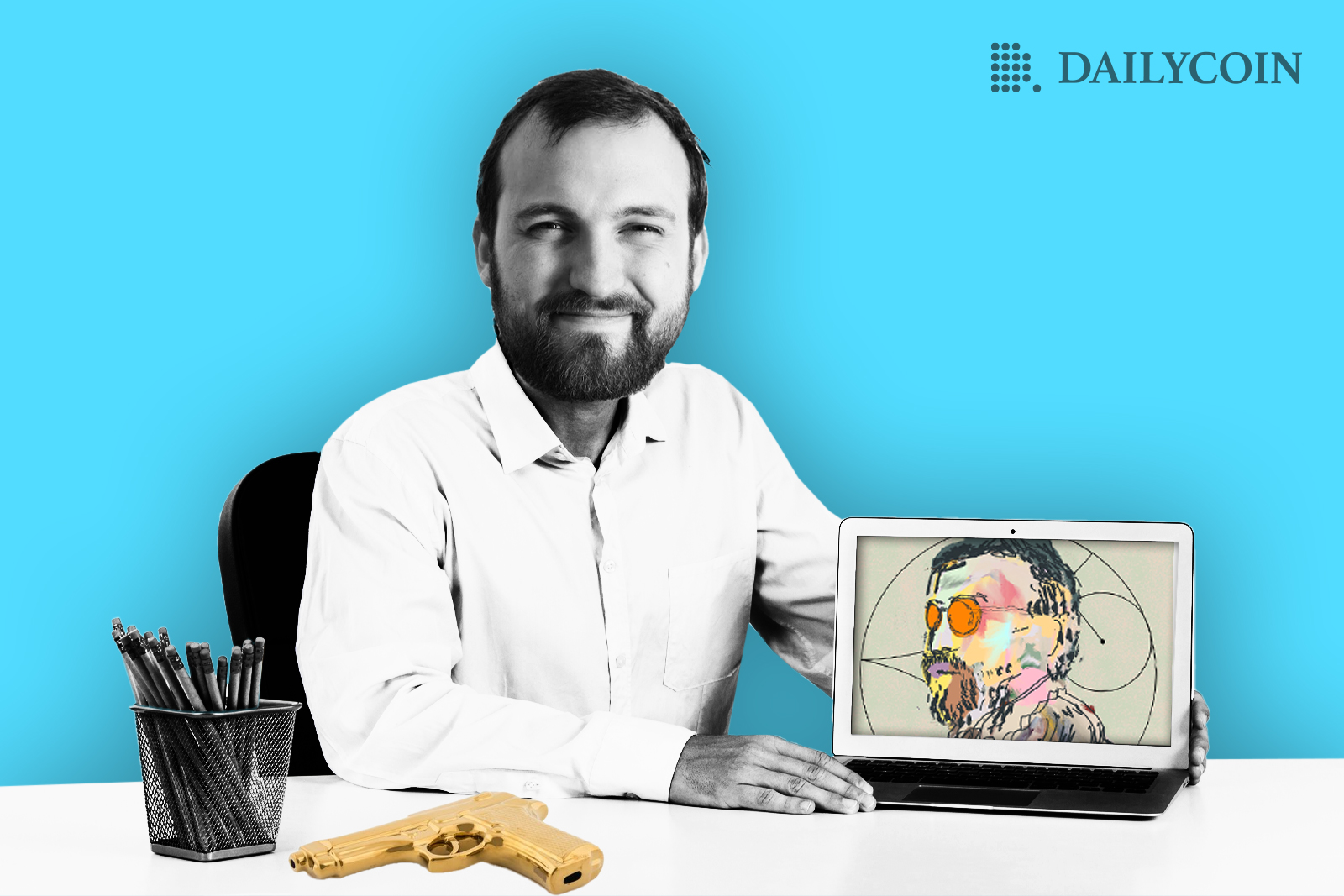
Last week, Charles Hoskinson, founder of the Cardano (ADA) blockchain and the CEO of London headquartered blockchain tech company IOG, changed his Twitter profile picture to a jpeg image of an NFT portrait featuring himself.
The founder’s new profile picture was not taken positively by Crypto Twitter. Hoskinson’s gesture of “right clicking and saving” a jpeg image instead of buying the NFT from the owner or crediting the artist garnered a lot of complaints and concerns.
Sponsored
In a rebuttal to Crypto Twitter’s opinions, Charles Hoskinson explained that the artist and NFT owner didn’t mind because it supposedly increased the value of their work and product since it had a historical association with the likes of the founder, and he paid artists in “exposure.”
The founder’s response to the complaints was not taken lightly by the crypto community, as concerns arose about the founder’s disregard for the tenets surrounding NFTs and digital ownership.
Sponsored
Despite coming under fire from the broader community for his response, the founder stood his ground, adding spice to the argument by taunting the community and questioning the fundamentals of the NFT contracts, ownership, and more.
#NewProfilePic pic.twitter.com/X1AKNXsOHD
— Charles Hoskinson (@IOHK_Charles) January 3, 2023
I Liked it, So I Used It…
NFTs are inadvertently at the forefront of digital ownership. They play an important role in Cardano’s (ADA) upgraded ecosystem. However, the rowdy founder may not agree with the fundamentals of digital ownership established by NFTs.
The founder justified his stance in a tweet claiming that “he liked it, so he used it.” However, many enthusiasts took offense to the founder’s gesture and shared their concerns.
Charles, buying and holding pieces from many of the CNFT projects that have brought life to Cardano in unexpected ways is a great way to show your support for the decentralized growth of the blockchain. Right-click saving is taboo in this world where digital ownership trumps all.
— $phobar 🐐 (@LarryMiles) January 3, 2023
The artists behind the NFT profile picture supported the founder, saying that they don’t mind the founder using their artwork.
We definitely don’t mind, thank you @IOHK_Charles. Love that you appreciate the art.
— JAR heads | NFT (@JARStudioNFT) January 3, 2023
However, despite the artists and the founder coming out with their initial stances, the crypto community continued to share their concerns and disagreements with the founder on the forum.
are you the owner of the NFT? if not your opinion isn't valid, a famous person can't steal a painting from my house because the artist doesn't mind
— thotman (@thotman__) January 3, 2023
What Is It That We Really Own?
Charles Hoskinson later doubled down and shared a 13-minute video on Twitter, again justifying his stance and bringing the specifics of the contracts in NFTs into question. The founder compared digital art NFTs with physical art, adding that NFT owners do not necessarily “own” the intellectual property but rather a digital object or representation on the blockchain.
The founder shared in the video response that he didn’t mind that his likeness was being used without permission and supported creative commons and open sourcing, as long as they don’t misrepresent him.
Hoskinson continued that the specifics of owning the intellectual property of NFTs needs to be clarified. He justified that an artist can always create another similar art piece as a limited edition NFT because there is no clause in the contract stopping the NFT creator from doing so.
Hoskinson adds that there should be a standard, similar to Creative Commons, that issuers can attach to their NFTs that establishes a notion for the rights and usage of the content. The Cardano founder later brought many interesting points into question, such as litigations, decentralized identities (Dids), ‘Real-Fi,’ regulations, and more in the video.
He claims that the crypto community as a whole should unite and set a standard for the terms of use for NFTs and transition it from the ‘DeFi world’ to the ‘RealFi world,’ where it is more regulated and defined.
He concludes that NFTs have a lot of potential, as they are in the top five based on volume and value. NFTs, in the future, should move towards being cross-blockchain and have enough legal agency and durability to be used by ‘dense’ intellectual property industries to catalyze adoption.
PFP, Art, and Sharing https://t.co/QtL5ae97er
— Charles Hoskinson (@IOHK_Charles) January 3, 2023
Crypto Twitter Reacts (Again)
Crypto Twitter had mixed reactions to Charles Hoskinson’s video. Some enthusiasts agreed with the points raised by the founder in his video, claiming that the lack of a license is a problem for NFTs.
About NFT Ownership cc @IOHK_Charles:
— Patrick Tobler (@Padierfind) January 4, 2023
One of the biggest issues with NFTs is that it's unclear what you're actually purchasing.
Without attaching a valid License to an NFT, you're just buying a useless link to a jpg.
You might not want to hear it but its the truth.
1/n
However, despite the justification from the founder, a community member chimed in, claiming that the founder should have bought the NFT because that’s how you support artists. However, the gesture was still ultimately a positive step, as it showed interest from the founder, the user claims.
Chiming in my thoughts on the @IOHK_Charles PFP situation - he should have bought the NFT. Plain & simple. That’s how we support our artists in this space.
— blakelock.jpg (@blakelockbrown) January 4, 2023
However, I would still say this move was a positive step in the right direction. 🧵
Despite justifying his stance, the founder added to the heat, taking a dig at the broader community, asserting that he will continue to “right click.”
That's it, I'm sooo right clicking. I'm right clicking so hard. pic.twitter.com/drZ4YhGxvI
— Charles Hoskinson (@IOHK_Charles) January 4, 2023
To which a community member replied that right-clicking an NFT is still taboo.
Right-clicking an #NFT is equivalent to taking possession of someone else's car.
— monad_alexander (@monad_alexander) January 3, 2023
Yes, you have it and can use it, but the registration is what determines ownership - not possession of the car.
(Preemptive "possession is 9/10ths of the law")
On the Flipside
- The Jarhead NFT was sold for 10,000 ADA, or $2,672, after Charles Hoskinson used it as his profile picture.
- NFT licenses exist. NMKR, one of the largest NFT minting platforms on Cardano, has created a suite of web3 tools that allow creators to license their NFTs.
Why You Should Care
NFT ownership and contracts are still ambiguous for traditional users. Charles Hoskinson raised many interesting points and set the course for a dialogue that could establish a standard for the NFT space. While many users and institutions have adopted NFT and web3 technology, the space has yet to develop a stable framework for its terms and conditions that is understandable to everyone.
Read more:
Cardano (ADA) Founder Charles Hoskinson Uses Someone Else’s NFT as Profile Pic
